Potential trouble spots for MLB contenders

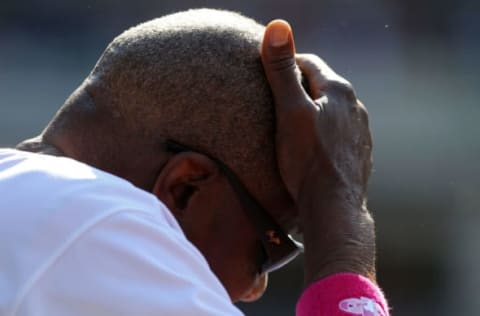
Unlike the NBA, the MLB landscape is wide open right now. (Although baseball would probably kill to have a Cavs-Warriors III on their hands.) There are certainly teams in each league (Houston Astros, Washington Nationals) who have had outstanding starts to 2017, but there’s a reason no team has better than 4:1 odds to win the title right now; every team has holes.
Now it is still mighty early in the season as we are just around the quarter pole, so these weak spots can be remedied in house with a player who is struggling turning the corner, or the team promoting from within their farm system. We’re also still a ways from the trade deadline when we will inevitably have several of the teams coming up in these slides looking to be buyers come the end of July. There are enough teams slipping in the standings that we could have a busy deadline.
For today, we’ll take four contenders from each league who would be in the playoffs if they started today (sorry Boston and Chicago) and look at one player who has either gotten off to a slow start, could potentially be trouble down the line, or is dealing with an injury that might hamstring the team. A potential trouble spot for each team.
We won’t go position-specific (i.e. the closers in Washington), but rather choose a specific player so we can go a bit into the nitty gritty on the player, deciding whether the best option is to simply give the player time, whether there is an in-house option to fix the problem, or whether there might be a decent trade target out there to solve the issue.
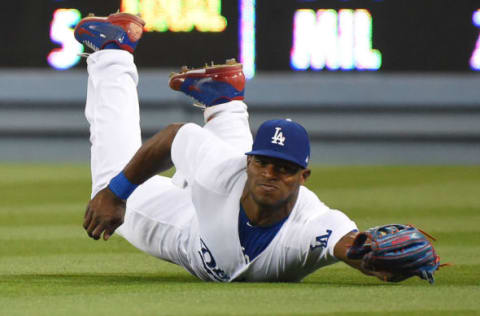
Los Angeles Dodgers: Yasiel Puig
At first blush, Puig might seem like a strange choice for the Dodgers. He’s actually having a pretty solid season, hitting .250 with seven home runs and four steals. His wRC+ is 99, which means he has basically been a league-average bat. He hasn’t been spectacular, but he’s been just fine. However, there has been one aspect of his game where Puig has been terrible: batting against left-handed pitchers. In 41 at bats, Puig is hitting just .171 with only one extra-base hit, good (or more likely, bad) for a wRC+ of 23 against southpaws. That means he’s been roughly 77 percent worse than a league-average hitters when it comes to hitting left-handed pitching this season. And what is the one weakness we hear more often about the Dodgers than anything else? That they can’t hit left-handers.
Puig should theoretically be one of their better hitters in this situation. He’s a right-handed batter who has plenty of success when he doesn’t have the platoon advantage (wRC+ of 133 against right-handed pitchers).
So what is going on with Puig? The answer, most likely, is that this is simply a case of the small sample size bug.
In 2016, Puig hit for basically the same average, but with a lot more power against left-handed pitchers, giving him a wRC+ of 110 against lefties. For his career, Puig has slashed .272/.359/.451 against lefties compared to .289/.357/.475 against righties – those lines are quite close and suggest that, with time, Puig’s 2017 struggles against lefties should dissipate and, with that, so should some of the Dodgers’ team-wide struggles. Puig has been the Dodgers’ worst hitter against lefties in 2017, so regressing him back to at least average against lefties would do wonders for L.A.
Verdict: Give the player more time.
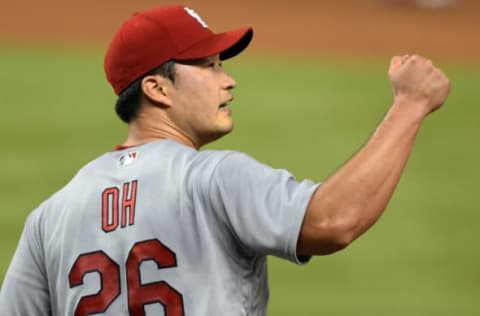
St. Louis Cardinals: Seung Hwan Oh
The St. Louis Cardinals are one of the more surprising division leaders right now (the Twins, who we left out of this discussion – sorry Minnesota – are probably the most surprising), at least if the preseason projections were to be believed. The Cardinals always seem to be in the picture, however, so baseball fans probably shouldn’t be too surprised to see them here once again.
So far, the Cardinals have used a slightly-above-average offense (wRC+ of 101) and an excellent rotation (3.3 WAR from starters ranks sixth this season) to propel them to their 21-15 start to the season. While their defense (which ranks 29th according to Defensive Runs Saved) has been a bit of an issue, that’s a team-wide problem, and we’re looking for individual players here.
If you’re looking for an individual player who may begin to falter as the season goes along, turn your eyes to the backend of the Cardinals’ bullpen. Seung Hwan Oh made his transition to MLB from Japan (and Korea before that) in 2016 and did so with aplomb, posting a 1.92 ERA in 79.2 innings and winning the closer’s role partway through the season.
On the surface, things are still fine with Oh. He has saves in 10 of his 11 opportunities, and his only blown save came all the way back on Opening Day. However, there are signs just below the surface that suggest there may be trouble in the future. Just look at how some of his numbers have changed greatly from 2016 to 2017:
| Year | K/9 | BB/9 | HR/9 | ERA | FIP | xFIP | LD% | GB% | Hard% |
| 2016 | 11.64 | 2.03 | 0.56 | 1.92 | 2.13 | 2.88 | 19.5 | 40 | 34.2 |
| 2017 | 6.27 | 3.38 | 1.45 | 2.89 | 5.15 | 5.66 | 23.3 | 28.3 | 30.6 |
Those numbers are worse across the board and culminate in a FIP that is nearly two and a half times larger in 2017 than 2016.
The good news for the Cardinals is that their current setup man, Trevor Rosenthal, would be a perfect fit for the closer’s role should Oh begin to slip. Rosenthal has a 1.88 ERA (and 1.06/1.08 FIP/xFIP) in 14.1 innings and has been absolutely electric in 2017, looking a lot like the Rosenthal of 2014-15 who saved a combined 93 games in those two seasons.
Verdict: In-house option (if the time comes).
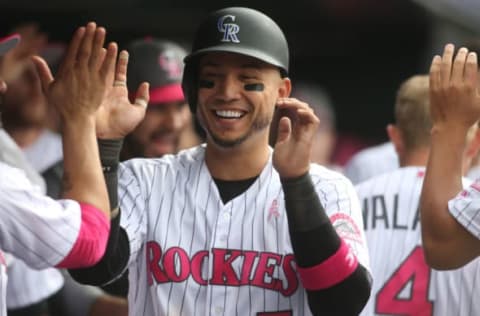
Colorado Rockies: Carlos Gonzalez
There’s almost a sad and sweet irony that the season when the Rockies look like they might be back as contenders sees CarGo having his worst output in recent memory. The 31-year-old has been with the team since 2009, two years after their magical “Rocktober” pennant-winning season. Gonzalez was able to make the playoffs in his first year with the team, but the team lost in the first round and hasn’t been back since. In fact, they haven’t had a winning season since 2010, and as a result, CarGo’s name has been on the trade market each and every year.
The Rockies never pulled the trigger on a Gonzalez trade, and they may regretting that now. As the rest of the team is making vast improvements (especially on the run prevention side of things), Gonzalez has seen his numbers drop in each of the past three seasons, especially in the power department. He has seen his slugging percentage go from .591 in 2013 to .540 in 2015 (he missed over half of 2014) to .505 in 2016 and now sits at a paltry .315 in 2017. That’s the same slugging percentage as Dee Gordon, Kevin Kiermaier and Jose Reyes this season. It’s less than half the slugging percentage of Yonder Alonso. Only seven hitters with as many plate appearances this season have a slugging percentage that low. Don’t forget, CarGo still plays half his games in Coors Field. As a result, no hitter in baseball has been a bigger drain on his team in 2017, by FanGraphs offensive runs formula, than Gonzalez.
That’s a massive drag for an up-and-coming team that is currently trying to stay ahead of the prohibitive favorites in L.A. So what’s been the deal with CarGo? Well, he is hitting more ground balls, but honestly, it mostly looks like another case of bad luck. He’s still hitting the ball hard (36.4 percent hard hit ball rate in 2017 is actually better than his career rate) and his plate discipline has stayed right in line with seasons past. One thing to note is that he is struggling with fastballs this season, a potential sign of his bat slowing down (he is an older 31). That being said, CarGo should be able to heat up sooner than later, which could really make this Colorado team scary. Even scarier than they are now.
Verdict: Give the player more time.
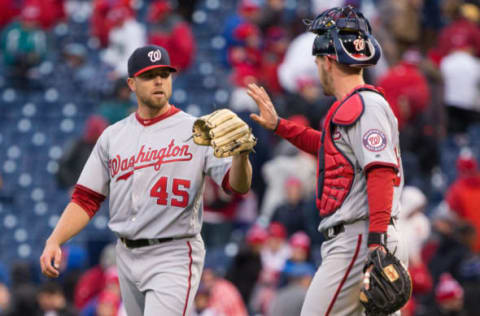
Washington Nationals: Blake Treinen
This was both the easiest and the hardest team to choose a potential trouble spot for. On the one hand, it’s so obvious: the bullpen. But as noted earlier, we want specific players here, not broad areas of struggle.
The entire Nationals’ bullpen has been a disaster this season, with a curse seemingly coming over each pitcher who deigns to attempt to take the role of closer. It’s as if we’re seeing a warped, bullpen-centric version of The Sword and The Stone set in modern-day Washington.
First, the Nationals chose Blake Treinen. He locked down his first two attempts of the season, but blew his third chance, gave up two runs in his next attempt, and was removed from the position. Then it was Shawn Kelley who Dusty Baker turned to for three saves from April 18-21 before he was too tired to go on April 22, so Koda Glover got the gig for a few days. Glover was worked back out of the role after a two-run outing in Coors Field. Enny Romero has picked up one save (and two blown saves) along the way, and now Matt Albers looks like he might be the man, as Kelley blew another save this weekend. Albers is a 12-year veteran who before this season was most famous for not having a career save, so something tells me he won’t last either.
The whole situation is a cluster eff, which leads me to believe that Treien will end up back with the role at some point this season since he was the chosen man at the beginning of the season. This is bad news for the Nats. Treinen has an ERA over 8.00 this season (8.10) and has walked 5.4 batters per nine as he simply has not been able to gain control of the zone. If he has a decent stretch of games, though, his name may pop back up in the great round robin of Nationals’ closers. The situation is a mess and probably wakes Dusty Baker up in a cold sweat three to four times a night.
The worst part is the fact that there is the world’s most obvious solution to seemingly everyone outside of the Nationals’ front office sitting right in front of Washington: David Robertson. The ten-year vet is having another nice season, but he is doing so for a White Sox team that is clearly looking to the future and hoping to cash in on their “right now” chips to get a few “future” chips. How on earth this trade hasn’t been made yet is one of the top five most unsolvable mysteries in the history of mankind.
Verdict: Just get Robertson already.
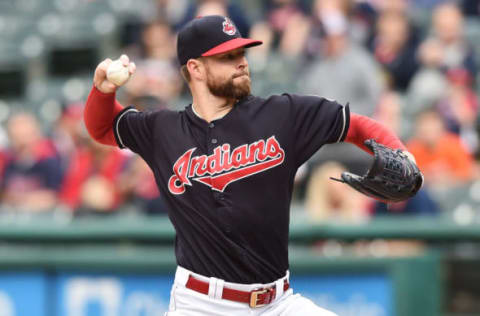
Cleveland Indians: Corey Kluber
This one is a two-fold worry. The first (and far more legitimate) worry is about Kluber’s injury. Kluber (top ten in the Cy Young vote each of the past three seasons) is currently dealing with a back issue that has him out of the rotation and without even so much as a timetable.
The other worry with Kluber is that his ERA has ballooned to 5.06 in 2017, but that doesn’t worry me as much. Kluber has always gotten off to slow starts. His career ERA in April/March is 4.04, the highest of any month. Last year his ERA was above 4.00 at the end of May, and if we take out his last start before hit the DL – which seems reasonable considering he may have been pitching through injury – his ERA was a far more palatable 4.19. Kluber’s xFIP this season (3.60) is nearly identical to last season (3.50), as he has been victimized by a HR/FB rate that is nearly double his career rate. He’s striking out as many as he ever has and his velocity is in line with previous seasons.
It is certainly worth monitoring that his spike in home runs can be at least partially explained by the fact that he is allowing harder contact this season, but the injury is certainly the more troubling of the two worries.
Cleveland is turning to a pretty solid fill-in for Kluber in the form of Mike Clevinger, but they don’t have tons of depth at the starting pitching position should Carlos Carrasco or Danny Salazar go down to injury at some point while Kluber is still out. Those two guys are both severe injury risks and Kluber is supposed to be the rock who doesn’t miss time at the top of the rotation.
Cleveland should be fine, their division is among the weakest in baseball (sorry Minnesota about all the shade, both direct and indirect, in this article) and they have one of the best managers in baseball to help navigate these injuries, but if Kluber’s back injury turns into a lingering one, that could be a pretty massive blow.
Verdict: Let it play out for now, but if they lose another starter, it might be time to start targeting a Jose Quintana-type to shore up the top of the rotation.
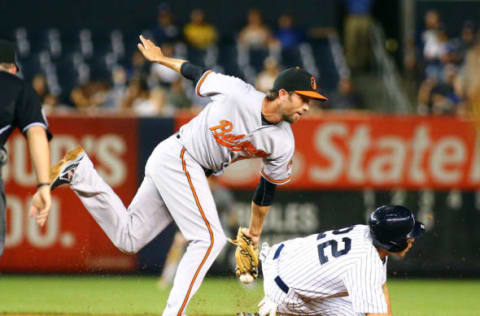
Baltimore Orioles: J.J. Hardy
Similar to St. Louis, Baltimore seems to hang around the contender zone every year despite a roster that often suggests otherwise. In Baltimore’s case, the team has managed to get by with mediocre starting pitching thanks to a strong bullpen and lots of home runs, and that formula hasn’t been much different in 2017. Their bullpen has been a bit worse (it could have been Zach Britton’s forearm to grab the potential trouble spot here just as easily) and the rotation a bit better, but if the O’s want to stick around for the long haul, the offense has to get back into the top tier.
Their 48 homers rank outside the top ten, and their offense as a whole (wRC+ of 99) ranks just 15th. The biggest downer on the offensive side of things has been their 34-year-old shortstop, J.J. Hardy. Mark Trumbo has been a bummer of his own sort (wRC+ of just 69; -0.5 fWAR), but he also has four home runs and has driven in 17 while scoring 19 times.
Hardy is hitting just .203 with one homer and has just eight runs and nine RBI, despite getting 130 plate appearances so far this season. His plate discipline is worse than it has been in seasons past and he’s just not hitting the ball that hard anymore. Not to mention the fact that the magical rebounding skills of 34-year-old shortstops are pretty limited.
It’s not as if the Orioles have a nice easy solution, though. Their top shortstop prospect (Ryan Mountcastle) would be perfect… If he wasn’t 20 years old and playing in High-A right now. It’s easy to imagine Manny Machado sliding back to shortstop and still being dominant, but it’s not as if the Orioles have a third baseman waiting in the wings, either. They could start to give more time to Ryan Flaherty, but again, that’s Ryan Flaherty we’re talking about. His wRC+ of 81 is nominally better than Hardy’s, but it’s not as if at age 30 Flaherty can expect a major breakout to be on its way.
The best move might be to look around the league, but it’s tough to find a team willing to part with a shortstop who is actually valuable. If Marcus Semien were healthy for Oakland he might be a perfect fit, but he’s currently on the 60-day DL. Zack Cozart might be worth the gamble, but Cincinnati isn’t going to sell while they’re still having their nice start to the season. The best bet is likely to wait until the deadline when either the Reds have dropped off a bit or Semien is back and healthy and teams are looking to make moves. It’s not ideal, but there doesn’t appear to be another path for the O’s.
Verdict: Let it play out, but always be looking for that replacement.
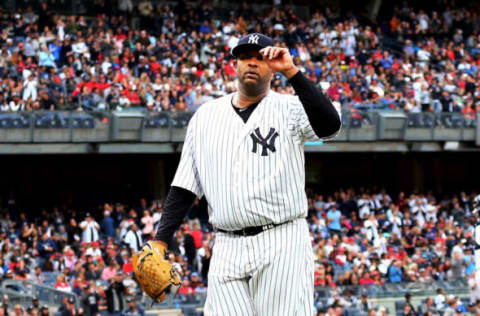
New York Yankees: CC Sabathia
The Yankees have little to complain about in 2017. They’ve improved their playoff chances by as much as anyone from the beginning of the season, they are getting great production from their young guns, and they now have Derek Jeter alongside Ruth, Gehrig, and Mantle in Monument Park.
If there has been one weakness for the team, though, it has been their veteran pitchers. Sabathia (36 years old) and Masahiro Tanaka (just 28, but a veteran on the team) have the two highest ERAs among their starters at 5.77 and 5.80, respectively. Tanaka should be fine, he’s younger and there are fewer signs that he has actually pitched that much worse in 2017, but Sabathia could be troubling.
Sabathia had a bit of a late-career rejuvenation in 2016, posting his first sub-4.00 ERA in four seasons. He did so by limiting damage on balls in play, inducing the second-highest soft contact rate of his career and limiting hard contact better than in any season since 2011.
The story has been much different in 2017. Sabathia is back to being hit hard (career high hard hit ball rate allowed) and with a repertoire that no longer allows him to blow hitters away, that’s a recipe for disaster. We will now see if Sabathia has another adjustment up his sleeve. When he began to lose his strikeouts, Sabathia was able to adjust and draw softer contact. Now that the softer contact is evaporating it will be interesting to see whether he can make yet another adjustment to extend his career. Given the professionalism of Sabathia and his ability to make adjustments in the past, I wouldn’t write him off. Plus, with the emergence of Luis Severino and Michael Pineda, the Yankees can afford to let him try some things out at the back end of the rotation.
Verdict: Give him some more time to see if he can wily-vet himself into one more successful run.
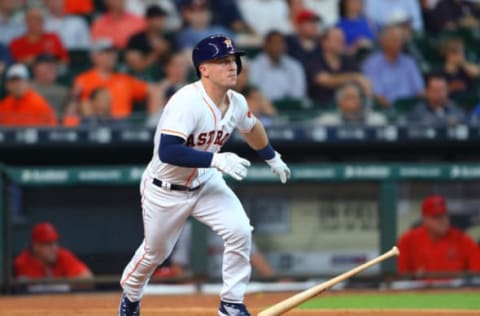
Houston Astros: Alex Bregman
Similar to New York, it’s hard to find trouble spots with Houston. They have the best record in baseball, they are allowing the fewest runs per game in the American League, and they are scoring the second-most in the league. It’s not as if this team is coming out of nowhere either, this squad was a popular World Series pick (including the pick of yours truly).
On the pitching side of things: Dallas Keuchel is back to pitching like an ace, Lance McCullers has been as good as advertised (while staying healthy), and the bullpen is due for some positive regression, if anything. Their offense has been great as well. George Springer is hitting leadoff homers left and right, Carlos Correa is officially hot after a slow April, and Jose Altuve is doing Jose Altuve things (14 combined homers and steals). Eight of their top ten hitters (by plate appearances) have a wRC+ over 100 this season. The two that haven’t: Carlos Beltran, a 20-year veteran who was brought in on a one-year deal this offseason, mitigating any struggles he might be having; and Alex Bregman.
Bregman was supposed to be among the breakout squad for 2017, and while he hasn’t been terrible (his wRC+ of 99 just barely missed the arbitrary cutoff line for the above distinction), he hasn’t quite been what the Astros were hoping for. He’s hitting just .258 and has just one long ball. His .342 on-base percentage and seven doubles help those two previous numbers out a bit, but his defense has also been a net negative, and he’s just been a bit disappointing after seemingly being primed for a breakout this season.
His pedigree is elite, as he was the number two overall pick of the 2015 MLB draft and was among the top prospects in baseball each of the past two seasons. He will almost certainly be fine. His inclusion on this list says a lot more about the Astros (they’re really freaking good) than it does about Bregman (he might yet be really freaking good), but there are a few signs here and there that mean that previous sentence has to read “almost certainly” and not just “certainly.”
Next: Chicago Cubs: Is it time to panic?
He’s turning over on the ball a lot more in 2017, with a ground ball rate (42.6 percent) way higher than his rookie season (28.9 percent). He’s also not pulling the ball as much and he’s hitting the ball softer. This may well all just be a sophomore slump, a young hitter not adjusting to pitchers quite as fast as they are adjusting to him, but it’s something to keep an eye on in Houston. A tiny chink in the armor of an otherwise bulletproof team.
Verdict: Give the player time. Duh.